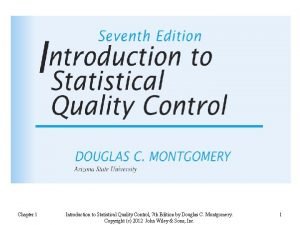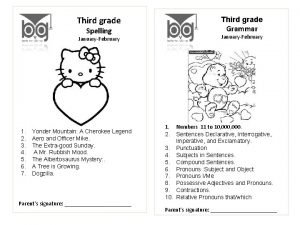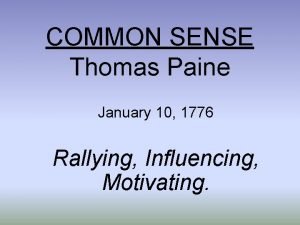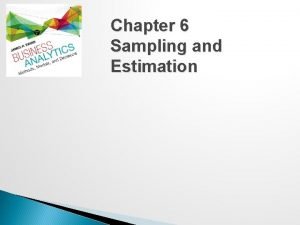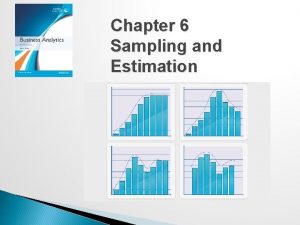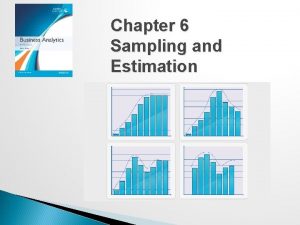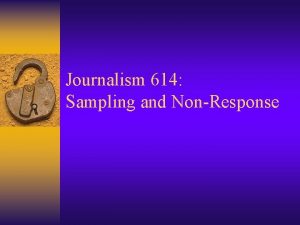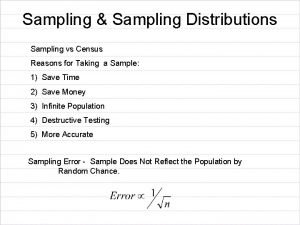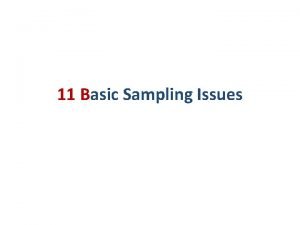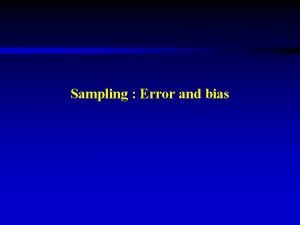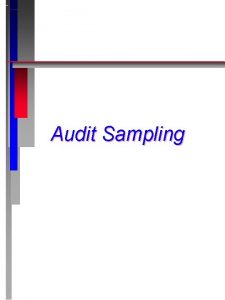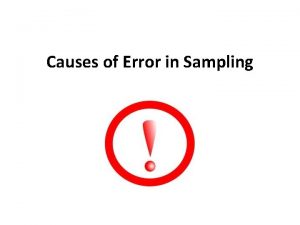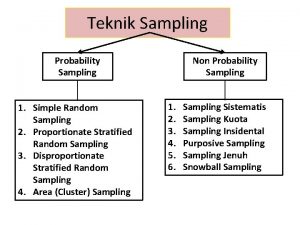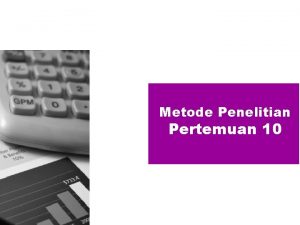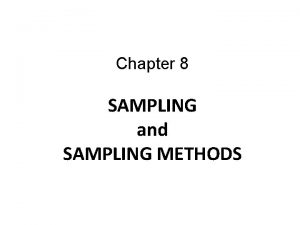LESSON 2 Statistical Sampling January 2016 Lesson Introduction




















































- Slides: 52

LESSON 2 Statistical Sampling January 2016

Lesson Introduction Given a surveillance requirement, the student will be able to apply statistical sampling techniques to supplier contract activities. Module 4, Lesson 2: Statistical Sampling 2

Lesson Objectives Upon completion of this lesson, you should be able to: § § § Relate the importance of sampling to QA surveillance. Distinguish between the three types of inspection: Normal, Reduced, and Tightened. Outline the internal Defense Contract Management Agency (DCMA) process of Zero-based sampling. Use randomization tools to generate random numbers for a simple random sample. Determine whether to initiate acceptance or non-acceptance activities based on sampling results. Module 4, Lesson 2: Statistical Sampling 3

Lesson Topics This lesson will cover these topics: § § § General background (DCMA policy, sampling terms, and Acceptable Quality Level (AQL)) Importance of sampling to QA Three types of inspection under a Sampling Plan Zero-based sampling Generating random sample numbers Initiating acceptance and non-acceptance activities Module 4, Lesson 2: Statistical Sampling 4

What’s In It For Me (WIIFM)? This lesson is important because: § § Zero-Based sampling is a tool used to ensure suppliers present and the Quality Assurance Specialist (QAS) accepts conforming product DCMA policy to use – Zero-based sampling – Random sampling techniques – Statistically valid sampling plan § Multiple sampling plans exist, including: – ANSI/ASQ Z 1. 4 -2008 – MIL-STD 1916 Module 4, Lesson 2: Statistical Sampling 5

DCMA Policy § § Use Zero-Based Sampling Use random sampling techniques Use statistically valid sampling plans Ensure supplier: – Meets contractual requirements – Understands and uses statistically valid sampling plans If product examination is determined to be the appropriate surveillance method, the QAS should verify the supplier’s conformance by sampling. Module 4, Lesson 2: Statistical Sampling 6

Sampling Terms Sampling System - collection of sampling schemes indexed by lot-size ranges, inspection levels, and Acceptable Quality Levels (AQLs) (i. e. , ANSI/ASQ Z 1. 4 -2008) DCMA Policy: The QAS will use zero-based sampling unless otherwise stated in a Quality Assurance Letter of Instruction (QALI). Sampling System Sample Plan 1 Sampling Scheme Sample Plan 2 Sample Plan 3 Sample Plan 4 Module 4, Lesson 2: Statistical Sampling Sample Plan 1 Sampling Scheme Sample Plan 2 Sample Plan 3 Sample Plan 4 7

Sampling Terms, Cont. Sampling Scheme - combination of sampling plans with switching rules and provision for discontinuance of inspection (i. e. , Normal, Reduced, or Tightened) Individual Sampling Plan - plan stating sample size(s) and acceptance criteria (i. e. , AQL) Sample Plan 1 Sampling Scheme Sample Plan 2 Sample Plan 3 Sample Plan 4 Module 4, Lesson 2: Statistical Sampling 8

Sampling Terms, Cont. Attribute - a characteristic or property appraised in terms of whether it does or does not exist, (e. g. , go or no go) with respect to a given requirement Characteristic - a physical, chemical, visual, functional, or any other identifiable property of a product, material, or unit identified by the product specification, standard, drawing, etc. Defect - a departure of a quality characteristic from its intended level or state that occurs with a severity sufficient to cause an associated product or service not to satisfy intended normal, or foreseeable, usage requirements (ANSI/ASQ Z 1. 4 -2008) Nonconformity - a departure of a quality characteristic from its intended level or state that occurs with a severity sufficient to cause an associated product or service not to meet a specification requirement; a unit of product that contains one or more defects (ANSI/ASQ Z 1. 4 -2008) Module 4, Lesson 2: Statistical Sampling 9

Sampling Terms, Cont. Lot or Batch - shall mean “inspection lot” or “inspection batch, ” i. e. , a collection of units of product from which a sample is drawn and inspected to determine conformance with the acceptability criteria, and may differ from a collection of units designated as a lot or batch for other purposes (e. g. , production, shipment, etc. ) (ANSI/ASQ Z 1. 4 -2008) Lot or Batch Size - the number of units of product in a lot or batch Homogeneity - manufactured under essentially the same conditions and essentially at the same time Module 4, Lesson 2: Statistical Sampling 10

Acceptable Quality Level (AQL) - the quality level that is the worst tolerable process average when a continuing series of lots is submitted for acceptance sampling. Process Average - the average percentage of nonconforming or average number of nonconformities per hundred units (whichever is applicable) of product submitted by the supplier for original inspection. Percent Nonconforming = Nonconformities per Hundred Units X Number Nonconforming Number of Units Inspected Number Nonconformities Number of Units Inspected X 100 Note: One or more nonconformities being possible in any unit Module 4, Lesson 2: Statistical Sampling 11

IMPORTANCE OF SAMPLING TO QA Lesson Topics: • • • Importance of Sampling to QA Three Types of Inspection Under a Sampling Plan Zero-Based Sampling Generating Random Sample Numbers Initiating Acceptance and Non Acceptance Activities Module 4, Lesson 2: Statistical Sampling 12

What is Sampling? Refers to a portion of a population that is representative of the population from which it was selected. In other words, the sample is a subset of the population. Population Sampl e Module 4, Lesson 2: Statistical Sampling 13

What is Acceptance Sampling? § Selecting and inspecting only a representative smaller subset (sample) selected from a larger lot or batch (population), for the purpose of making an accept/reject decision of an entire lot or batch based on the inspection results of the sample only. § Used by suppliers and DCMA to validate product quality. Module 4, Lesson 2: Statistical Sampling 14

Why Should We Sample? Accurate Assessme nt of the Populatio n Saves Time 100% Not Always Possibl e Module 4, Lesson 2: Statistical Sampling Why Sampli ng Cost Effectiv e Custom er Reques ts 15

What is Random Sampling? Produc t § § Random Sample Refers to a sampling procedure where every unit in the population has an equal chance of being selected as part of the sample Objective of Random Sampling: To ensure that the final samples to be measured or tested are representative of the population from which they were taken Module 4, Lesson 2: Statistical Sampling 16

Zero-Based Sampling Plans § Zero-Based sampling plans – Lot is accepted when zero defects are discovered – Lot is not accepted when one defect is discovered § Also referred to as: − Acceptance equals 0 (C=0) − Zero-Based Acceptance (ZBA) − Accept on Zero (Ao. Z) § During product examination – Use statistically valid sampling systems – Measure product characteristics – Ensure compliance with manufacturing specification requirements Module 4, Lesson 2: Statistical Sampling 17

Sampling Risks Acceptance of Nonconforming Product Customer’s Risk Producer’s Risk Non-Acceptance of Conforming Product Because the “lot” disposition is based on sample results, there is a probability of making an incorrect disposition concerning “lot” acceptance. Module 4, Lesson 2: Statistical Sampling 18

THREE TYPES OF INSPECTION UNDER A SAMPLING PLAN Lesson Topics: • • • Importance of Sampling to QA Three Types of Inspection Under a Sampling Plan Zero-Based Sampling Generating Random Sample Numbers Initiating Acceptance and Non Acceptance Activities Module 4, Lesson 2: Statistical Sampling 19

Three Types of Inspection Under a Sampling Plan § Normal Inspection § Reduced Inspection § Tightened Inspection Module 4, Lesson 2: Statistical Sampling 20

Types of Inspection Normal Inspection § Inspection under a sampling plan that is used when there is no evidence that the quality of the product being submitted is better or poorer than the specified quality level Reduced Inspection § Inspection under a sampling plan using the same quality level as normal inspection, but requiring a smaller sample for inspection Tightened Inspection § Inspection under a sampling plan using the same quality level as normal inspection, but requiring more stringent acceptance criteria Module 4, Lesson 2: Statistical Sampling 21

Switching Rules • Preceding 10 lots accepted • Total nonconforming less than limit number (optional) • Production steady • Approved by responsible authority REDUCE D START 2 of 5 or fewer consecutive lots are not accepted NORMA L • Lot not accepted • Lot accepted but nonconformities found lie between Ac and Re of plan • Production irregular • Other conditions warrant TIGHTEN ED 5 consecutive lots accepted When switching from normal to tightened or reduced inspection, the sample size changes but not the AQL. Module 4, Lesson 2: Statistical Sampling 5 lots not accepted while on Tightened inspection Discontinue inspection under Z 1. 4 22

ZERO-BASED SAMPLING Lesson Topics: • • • Importance of Sampling to QA Three Types of Inspection Under a Sampling Plan Zero-Based Sampling Generating Random Sample Numbers Initiating Acceptance and Non Acceptance Activities Module 4, Lesson 2: Statistical Sampling 23

Zero-Based Sampling Process overview includes making determinations of: § § § Population Criteria Method Sample size Acceptance Decisions Module 4, Lesson 2: Statistical Sampling 24

Zero-Based Sampling Process Details Method • Determine the sample system and size Determine contractual (supplier) sampling requirement: § ANSI/ASQ Z 1. 4 -2008/MIL-STD-1916/Government approved plan Use zero acceptance number sampling plans (Squeglia) § Unless directed by the customer [Quality Assurance Letter of Instruction (QALI)] Use contract or DCMA criteria for determining AQL Select sample size per the sampling system tables Identify accept/reject number from system tables § Zero-Based (C=0) when not contractually mandated Module 4, Lesson 2: Statistical Sampling 25

Zero-Based Sampling Process Details, Cont. Method • Determine the sample system and size (cont. ) Samples are selected independent of supplier's sample When AQL is not specified in contract or QALI: § AQL=0. 4 - All critical characteristics on a Critical Safety Item (CSI) § AQL=1. 0 – Complex/critical products and/or CSI significant characteristics § AQL=4. 0 – Non-complex/non-critical product Sample size is determined by the AQL and lot size Module 4, Lesson 2: Statistical Sampling 26

Zero-Based Sampling Process Details, Cont. Method • Determine the sample system and size (cont. ) Sample selection is dependent on lot formation § Identified by product serial number, production number, some other form of identification § Identified by shift, by machine, by operator, by model, by customer designation Product unit identification § Allows for randomization using tables of random numbers § Random sampling shall be used even without unit identification or traceability Module 4, Lesson 2: Statistical Sampling 27

Zero-based Sampling Plan: AQL Chart Module 4, Lesson 2: Statistical Sampling 28

Zero-based Sampling Plan: Example Module 4, Lesson 2: Statistical Sampling 29

Product Examination Sheet Sampler Tab Product Examination Sheet also contains an automated Zero-Based AQL chart that identifies sample size. Product Examination Sheet Module 4, Lesson 2: Statistical Sampling 30

Question and Answer What is the sample size if the lot size is 285 and it is a critical characteristic for the product which is a critical safety item? A. B. C. D. 125 48 29 11 Select the graphic to view the chart. Module 4, Lesson 2: Statistical Sampling 31

Question and Answer What is the sample size if the lot size is 35, 000 and the product is a non-complex item? A. B. C. D. 60 315 108 29 Select the graphic to view the chart. Module 4, Lesson 2: Statistical Sampling 32

GENERATING RANDOM SAMPLE NUMBERS Lesson Topics: • • • Importance of Sampling to QA Three Types of Inspection Under a Sampling Plan Zero-Based Sampling Generating Random Sample Numbers Initiating Acceptance and Non Acceptance Activities Module 4, Lesson 2: Statistical Sampling 33

Generating Random Sample Numbers The Product Examination Policy page includes Helpful QA Tools: 1711 Random Generator tool Random Generator 5 (Excel© spreadsheet) www. Random. org (for other random generators) Module 4, Lesson 2: Statistical Sampling 34

Using Random. Org Random Number Generator www. random. org/intergers/ Module 4, Lesson 2: Statistical Sampling 35

Practice using www. random. org/integers/ to obtain a random sample. § Lot size of 1200. § Sample size of 34. Module 4, Lesson 2: Statistical Sampling 36

INITIATING ACCEPTANCE AND NONACCEPTANCE ACTIVITIES Lesson Topics: • • • Importance of Sampling to QA Three Types of Inspection Under a Sampling Plan Zero-Based Sampling Generating Random Sample Numbers Initiating Acceptance and Non Acceptance Activities Module 4, Lesson 2: Statistical Sampling 37

Initiating Acceptance and Non-acceptance Activities § Execute – Perform sampling – Document results § Decisions – Acceptance – Non-acceptance Module 4, Lesson 2: Statistical Sampling 38

Sampling Process Details Execut e • Perform the sampling and document results Perform examination of the product characteristics, features, or specification requirements as identified in the GCQA surveillance plan § Accept/reject number from sampling system tables − Zero-Based (C=0) - accept on 0 defects, reject on 1 defect Document the results of the examinations in accordance with agency policy requirements § Adjust risk assessment based on results § Update GCQA surveillance plan accordingly Module 4, Lesson 2: Statistical Sampling 39

Sampling Process Details, Cont. Decisio ns • Initiate acceptance or non-acceptance actions Notify the supplier of the results § Accept/non-accept decision Verify supplier’s compliance with: § § § Lot rejection Requirements concerning lot screening Defect investigation Product replacement Corrective action Module 4, Lesson 2: Statistical Sampling 40

Sampling Process Details, Cont. Decisio ns • Initiate acceptance or non-acceptance actions (cont. ) When using Zero-Based sampling, the entire lot is rejected when one (1) defect is found in the sample § The supplier shall tender to the Government for acceptance only supplies that have been inspected in accordance with the inspection system and have been found by the supplier to be in conformity with contract requirements… The supplier shall remove supplies rejected or required to be corrected. Adjust sampling levels as provided for in sampling system or policy Module 4, Lesson 2: Statistical Sampling 41

Summary Having completed this lesson, you should now understand: § § § Module 4, Lesson 2: Statistical Sampling is important to ensure acceptance of conforming product. Three levels of inspection: normal, reduced, and tightened. DCMA process for sampling must be used. Use of a random number generator preferred; DCMA QA policy includes links to random number generator tools. DCMA policy mandates zero-based sampling unless otherwise specified by the customer. 42

Summary, Cont. Having completed this lesson, you should now understand: § Zero-based sampling system tables: – CSI critical characteristics use AQL of 0. 40% – Complex/critical products or DCMA identified significant characteristics use AQL of 1. 0% – Non-complex/non-critical products use AQL of 4. 0% § Module 4, Lesson 2: Statistical Sampling When using zero-based sampling, entire lot is rejected when one defect is found. 43

Other Training: CMQ 200, Statistical Sampling Module 4, Lesson 2: Statistical Sampling 44

Other Training: CMQ 200, Statistical Sampling, Cont. Module 4, Lesson 2: Statistical Sampling 45

Questions Module 4, Lesson 2: Statistical Sampling 46

Review Question 1 Which is NOT a reason to sample? A. B. C. D. 100% inspection is not possible Saves time and money Each product must be inspected Customer requests it Module 4, Lesson 2: Statistical Sampling 47

Review Question 2 What type of sampling plan is required by DCMA policy? A. B. C. D. Simple Zero-based ANSI/ASQ Z 1. 4 -2008 MIL-STD 1916 Module 4, Lesson 2: Statistical Sampling 48

Review Question 3 What AQL is required for a Critical Safety Item (CSI) critical characteristic? A. B. C. D. . 040% 0. 40% 4. 0% 1. 0% Module 4, Lesson 2: Statistical Sampling 49

Review Question 4 Inspection level for initial inspection starts at _____. A. B. C. D. Normal Reduced Tightened Variable Module 4, Lesson 2: Statistical Sampling 50

Review Question 5 When changing from Normal to Reduced or Tightened inspection, the QAS is changing the: A. B. C. D. Criteria Lot size Population size Sample size Module 4, Lesson 2: Statistical Sampling 51

Review Question 6 When is a lot rejected if using the Zero-based plan? A. B. C. D. 0 defects 1 defect 2 non critical defects 2 defects Module 4, Lesson 2: Statistical Sampling 52
 January 2017 chemistry regents answers
January 2017 chemistry regents answers Probability sampling vs non probability sampling
Probability sampling vs non probability sampling Advantages and disadvantages of sample survey
Advantages and disadvantages of sample survey Types of probability sampling
Types of probability sampling Contoh time sampling
Contoh time sampling Cluster vs stratified sampling
Cluster vs stratified sampling Snowball sampling example
Snowball sampling example Natural sampling vs flat top sampling
Natural sampling vs flat top sampling Introduction to statistical quality control montgomery
Introduction to statistical quality control montgomery Introduction to quantum statistical mechanics
Introduction to quantum statistical mechanics Introduction to statistical quality control
Introduction to statistical quality control Lesson 3.5 what is wrong with these surveys
Lesson 3.5 what is wrong with these surveys Mozart who was born on january 27 1756
Mozart who was born on january 27 1756 Zodiac for january 20
Zodiac for january 20 4 january 1643
4 january 1643 January february march april
January february march april January february maruary
January february maruary January 2012 chemistry regents
January 2012 chemistry regents June 2012 chemistry regents answers
June 2012 chemistry regents answers Life of a plant poem by risa jordan
Life of a plant poem by risa jordan History ia mark bands
History ia mark bands Respect character trait
Respect character trait Paula hurlock birthday
Paula hurlock birthday January 27 1756
January 27 1756 Mozart's grave
Mozart's grave January february spelling
January february spelling What is the theme for the month of january
What is the theme for the month of january Beetlejuice planet size
Beetlejuice planet size January 24 1848
January 24 1848 William lloyd garrison jr 1934
William lloyd garrison jr 1934 1995 january 23 nasa
1995 january 23 nasa His birth date was on 25 january 1759
His birth date was on 25 january 1759 An asset was purchased for $120 000 on january 1
An asset was purchased for $120 000 on january 1 Meridel lesueur, new masses, january 1932.
Meridel lesueur, new masses, january 1932. 1st january 2018
1st january 2018 How many syllables in discovery
How many syllables in discovery Lipsume
Lipsume Manage end user devices
Manage end user devices January comes before february
January comes before february January 19, 1809
January 19, 1809 When was poe born
When was poe born January 10th 1776
January 10th 1776 Spatial january
Spatial january Hello song peter weatherall
Hello song peter weatherall You must wash that shirt for tonight’s party
You must wash that shirt for tonight’s party Months of the year december
Months of the year december January 31 2006
January 31 2006 March april may june july
March april may june july Pro forma journal entries example
Pro forma journal entries example January 2012
January 2012 Mozart was born in salzburg ... 1756
Mozart was born in salzburg ... 1756 January 13 2006 calendar
January 13 2006 calendar Arvod cannot find work as a mall santa in january.
Arvod cannot find work as a mall santa in january.








